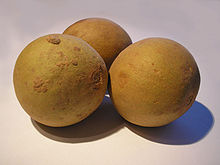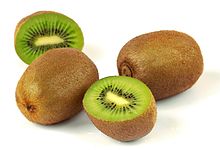Honey (
English pronunciation: /ˈhʌni/) is a
sweet food made by bees using
nectar from
flowers. The variety produced by
honey bees (the
genus Apis) is the one most commonly referred to and is the type of honey collected by
beekeepers and consumed by humans. Honey produced by other
bees and insects has distinctly different properties.
Honey bees form nectar into honey by a process of
regurgitation and store it as a primary food source in wax
honeycombs inside the
beehive.
Beekeeping practices encourage overproduction of honey so that the excess can be taken without endangering the bee
colony.
Honey gets its sweetness from the
monosaccharides fructose and
glucose and has approximately the same relative
sweetness as that of
granulated sugar.
[1][2] It has attractive chemical properties for baking, and a distinctive flavor that leads some people to prefer it over sugar and other sweeteners.
[1] Most
microorganisms do not grow in honey because of its low
water activity of 0.6.
[3] However, honey sometimes contains dormant
endospores of the bacterium
Clostridium botulinum, which can be dangerous to infants as the endospores can transform into toxin-producing bacteria in the infant's immature intestinal tract, leading to illness and even death
[4] (see
Health hazards below).
Honey has a long history of human consumption and is used in various foods and beverages as a sweetener and flavoring. It also has a role in religion and symbolism. Flavors of honey vary based on the nectar source, and various types and grades of honey are available. It is also used in various medicinal traditions to treat ailments. The study of
pollens and
spores in raw honey (
melissopalynology) can determine floral sources of honey.
[5] Because bees carry an
electrostatic charge, and can attract other particles, the same techniques of melissopalynology can be used in area environmental studies of
radioactive particles,
dust or particulate
pollution.
[6][7]
Honey is created by bees as a food source. In cold weather or when fresh food sources are scarce, bees use their stored honey as their source of energy.
[8] By contriving for bee
swarms to nest in artificial
hives, people have been able to
semi-domesticate the insects, and harvest excess honey. In the hive (or in a wild nest) there are three types of bee: a single female
queen bee, a seasonally variable number of male
drone bees to fertilize new queens, and some 20,000 to 40,000 female
worker bees.
[9] The worker bees raise larvae and collect the nectar that will become honey in the hive. Leaving the hive, they collect sugar-rich flower
nectar and return.
In the hive the bees use their "honey stomachs" to ingest and
regurgitate the nectar a number of times until it is partially digested.
[10] The bees work together as a group with the regurgitation and digestion until the product reaches a desired quality. It is then stored in
honeycomb cells. After the final regurgitation, the honeycomb is left unsealed. However, the nectar is still high in both water content and natural yeasts, which, unchecked, would cause the sugars in the nectar to ferment.
[8] The process continues as bees inside the hive fan their wings, creating a strong draft across the honeycomb, which enhances
evaporation of much of the
water from the nectar.
[8] This reduction in water content raises the sugar concentration and prevents
fermentation. Ripe honey, as removed from the hive by a
beekeeper, has a long shelf life and will not ferment if properly sealed.
[8]






















